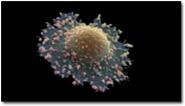1.2.2 Cell–cell signalling via secreted molecules
Extracellular signalling molecules are all fairly small, and are easily conveyed to the site of action; they are structurally very diverse. The classification and individual names of these mainly water-soluble mediators often reflect their first discovered action rather than their structure. So, for example, growth factors direct cell survival, growth and proliferation, and interleukins stimulate immune cells (leukocytes). However, to complicate matters further, they often have different effects on different cells, and so sometimes their names can appear confusing. Signalling via secreted signalling molecules can be paracrine (acting on neighbouring cells), autocrine (acting on the cell that secretes the signalling molecule), endocrine (acting on cells that are remote from the secreting cell) or electrical (between two neurons or between a neuron and a target cell).
i.In paracrine signalling (Figure 3b (i)) water-soluble signal molecules called cytokines diffuse through the extracellular fluid and act locally on nearby cells. This will usually result in a signal concentration gradient, with the cells in the local area responding differentially to the extracellular signalling molecule according to the concentration they are exposed to (this is an important strategy in development). In order to keep the effect contained, signalling molecules involved in paracrine signalling are usually rapidly taken up by cells or degraded by extracellular enzymes. An example of paracrine signalling involves the gaseous molecule nitric oxide (NO), which, among other effects, acts by relaxing smooth muscle cells around blood vessels, resulting in increased blood flow. As the NO molecule is small (and diffuses readily) and short-lived (so only having time to produce local effects), it fulfils the requirements for a paracrine signalling molecule perfectly.
ii.Autocrine signalling (Figure 3b (ii)) is an interesting variant of paracrine signalling. In this scenario, the secreted signal acts back on the same cell or group of cells it was secreted from. In development, autocrine signalling reinforces a particular developmental commitment of a cell type. Autocrine signalling can promote inappropriate proliferation, as may be the case in tumour cells.
iii.Endocrine signalling (Figure 3b (iii)) is a kind of signalling in which signals are transmitted over larger distances, for example from one organ, such as the brain, to another, such as the adrenal gland. For long-distance signalling, diffusion through the extracellular fluid is obviously inadequate. In such cases, signalling molecules may be transported in the blood. Secretory cells that produce signalling molecules are called endocrine cells, and are often found in specialized endocrine organs. Blood-borne signalling molecules were the first to be discovered and are collectively known as hormones, though they are chemically very diverse. They include steroid hormones (such as the sex hormones and cortisol), some peptide hormones such as insulin, and modified amines that can also act as neurotransmitters (see below) such as noradrenalin. Steroid hormones are biosynthesized from cholesterol. Because they are water-insoluble, they are transported in the blood by specific carrier proteins and are quite stable (their half-lives can be measured in hours or days). This is in contrast to water-soluble signalling molecules, which are much more prone to degradation by extracellular enzymes. Hence they tend to be short lived and are involved in short-term paracrine signalling.
iv.Electrical signalling (Figure 3b (iv)) via chemical transmission (also called synaptic signalling) is a faster and more specific form of cell–cell signalling. Nerve cells, or neurons, can convey signals across considerable distances to the next neuron in the neuronal network within milliseconds. By contrast, blood-borne messages can only operate as fast as blood circulates, but reach many more cellular targets in different tissues. The transfer of information from one neuron to the next is mediated by complex structures called synapses, which are essentially formed by a presynaptic terminal (neuron 1), a synaptic cleft (the tiny gap between the two neurons) and a postsynaptic membrane (neuron 2). When electrical signals reach the end of a neuronal axon (the thin tube-like part of neurons), molecules released from the axon can cross the physical gap between cells and bind to receptors in the target cell. These signalling molecules are collectively called neurotransmitters. Again, these are a diverse group of compounds, including amino acids such as glutamate, nucleotides such as ATP, and CoA derivatives such as acetylcholine.
In addition to its role as a neurotransmitter, can you recall what other roles ATP may have in cells?
ATP is used in phosphorylation reactions, as an energy currency and as a building block for nucleic acid synthesis. ATP is only one example by which localization and compartmentalization enables the same molecule to be used effectively for diverse purposes. You will encounter other examples later in this chapter.
